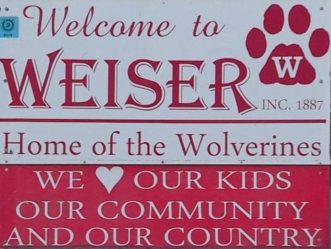The first graveyard of Weiser was near where the P. & I.N. depot now stands.
A Chinaman, an old lady and R.E. Said (known as “Rattle Snake Jack”) were buried here. Both the former were taken up. The latter, who had been killed as a consequence of a drunken brawl in a saloon, was unearthed when the P. & I.N. railway was under construction. His bones were scattered about, until a saloon keeper requested his skull, so it once again graced the place where it was wont to be while living.
The first grist mill of Weiser was built and owned by S. M. Jeffreys and Morehead, Sr. They took its power from the Jeffreys irrigating ditch. The same mill has recently been fitted up and again is doing service for the town. In the fall of 1882 it had a capacity of 50 barrels of flour per day. In Boise flour was then selling at $14 per barrel, and later for a short time it was the same in Weiser. This was owing to the unusual demand of the railroad employees. All provision was correspondingly high. Alfalfa, with its smiling fields, had not yet made its advent into our midst, hence there was then more grain grown in the surrounding country than at present.
In 1883 the number of scholars in the public school had swelled to over one hundred and two teachers were employed.
The first “teachers’ institute” was held in Weiser, November 7, 1883. The teachers in attendance were S. C Hale, A. Houlahan, Mr. and Mrs. D. Gorrie, F. Moore, Miss Florence Clark, C. М. Hixon and D. W. Shaw, who was the county superintendent. They decided seven years to be the proper age for admission to school. The superintendent made a strong address favoring a better state in educational interests, especially better school houses, with proper ventilation, etc.
In the fall of 1883 there was an attendance of 52 scholars in Sunday school, with D.P. Maryatt as superintendent.
The first telephone of Weiser was put between the P. O. and Dr. Williams’ residence in 1883. Dr. Williams was then postmaster of Weiser.
In the latter part of 1883 excitement prevailed in anticipation of the coming railroad. Weiser began to feel as if destined to be quite a metropolis. January 4. 1884, Weiser hailed with delight the first locomotive. The Leader of that time stated that “The first smoke stack ever seen in this region since Thomas Jefferson sent Lewis and Clark to smoke the pipe of peace along this stream, puffed its smoke within sight of town yesterday.”
A railroad reception and grand ball was given to welcome the Oregon Short Line Co., and many of their officials and employees to Weiser. P.M. Jeffreys, then known as “the silver-tongued orator,” welcomed the guests of the evening with a timely address. The question of locating the depot was still pending, but it was eventually put across the Weiser River, about one mile and a half south of town, in the district now known as “Sunny Side.” It was earnestly hoped that this was not a permanent location, as the river running between the town and the depot must cause serious interference owing to the high water sometimes backing backing up, rendering communication impossible. Under these conditions Weiser was very restless and entertained grave apprehensions of a near rival town. It was understood that the depot assumed the name of Weiser, but the name of the town had been changed from Weiser Bridge to Weiser by order of the post office department. Hence the town insisted that the new place was only “Weiser Station.” A number of buildings sprang up near the depot. Peter Pence, of Payette, put up what was then considered a fine large hotel. However, business was not suspended in the town, and some building continued.
In 1885 the Baptist church was built. The bell, costing $300. was donated by M. L. Hoyt, who was then the banker of Weiser. For a number of years this church was the only house of worship in the county and the doors were always open to ministers of all denominations in which to hold services.
In 1885 there was an Episcopal church organization in Weiser. We notice that they gave a “pink tea party” at the Hull hall, December 31, that was quite a social success. There was also a “Ladies’ Aid School Society” that was doing noble work by way of entertainments, etc., for school purposes, raising over $200 in this way. The first patent school desks were procured from this fund.
Balls were of frequent occurrence during those intermediate days. We quote the following from the Leader in reference to one of those occasions: “The other evening at the party a lady was heard to remark that ‘the best looking gentleman in the hall has a greasy spot on his coat.’ At this remark every man within hearing began examining his coat, which shows plain enough how vain the men are.”
We will also give a dream as published in the Leader of 1885. “The other day a party remarked to the Leader man as follows: ‘I dreamed the other night that I sold out my property in Weiser and wandered all over the United States. After a lapse of five years I returned to early scenes, and lo, behold! from a few shabby business houses, coarse, unpainted dwellings, the most of them unfenced and the tick-bearing sage-brush growing up to the doors; rough, ungraded streets; and the old rickety, tumble- down bridge above town, Weiser had changed to a lively, bustling place of over 2,000 inhabitants, with many fine residences, beautiful gardens, costly blocks of business buildings, a large iron bridge across the river, splendid church bridge edifices, a commodious court house and jail constructed of the best material, and above all a magnificent four-story brick school house, nicely furnished throughout had sprung up in place of the old one. I said to myself, what has caused all this change in so short a time? The reason was plain: Because the people had changed, and a more energetic class had possession than in my day. They all work together for the general good, improving all they could, and do not pull, growl and swear for one block or street, but unite for the welfare of the community. At this point I awoke and all these grand improvements faded from my view, and nothing but plain old Weiser remained in sight.’ The Leader man asked him if he believed in dreams, to which he replied: ‘Well, I have known some to come true more wonderful than the one just told.'”
Many of the old-timers were loth to agree with this dream in regard to a more energetic class being needed for the good of Weiser. In fact it was rather hard on either those who may have fallen under the hardships of those days, or those who were still at the front battling for the right.
In 1886 the railroad company changed the depot to its present site, one mile west of town. There was, even then, talk of connecting the town and depot with a street car line. But there was no building to speak of near the depot, the section house excepted, for five years.
[ Page 1 | 2 | 3 ]






